Case Study: Clinical Reasoning Cycle for Peter Mitchell's Care
VerifiedAdded on 2021/04/21
|8
|2218
|149
Case Study
AI Summary
This case study examines the application of the clinical reasoning cycle in nursing care, focusing on a 52-year-old patient, Peter Mitchell, who is overweight and has type 2 diabetes, along with a history of smoking, hypertension, depression, and sleep apnea. The assignment details the steps of the clinical reasoning cycle, including patient assessment, data collection, problem identification, goal setting, intervention planning, and evaluation. It emphasizes the importance of considering both subjective and objective data, synthesizing information from various sources, and prioritizing care needs based on evidence-based practice. The care plan focuses on managing Peter's obesity, particularly the obesity ventilation syndrome, controlling blood glucose levels, and addressing sleep apnea through lifestyle modifications and potential medical interventions. The essay highlights the clinical reasoning cycle's role in structuring patient-centered care and providing a rationale for interventions, concluding that the framework is essential for nurses to design and implement effective care plans. References to key literature are included to support the analysis.
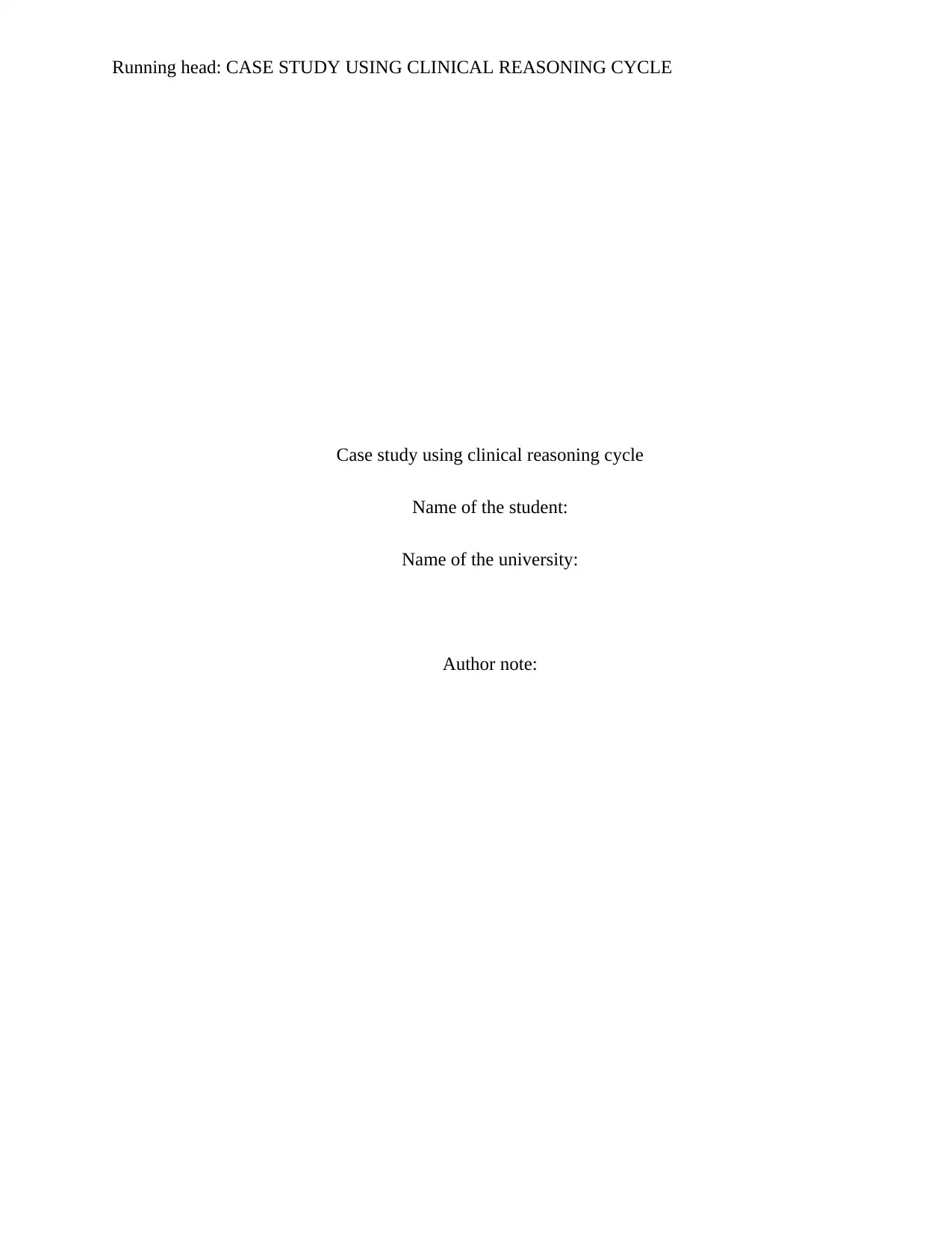
Running head: CASE STUDY USING CLINICAL REASONING CYCLE
Case study using clinical reasoning cycle
Name of the student:
Name of the university:
Author note:
Case study using clinical reasoning cycle
Name of the student:
Name of the university:
Author note:
Paraphrase This Document
Need a fresh take? Get an instant paraphrase of this document with our AI Paraphraser
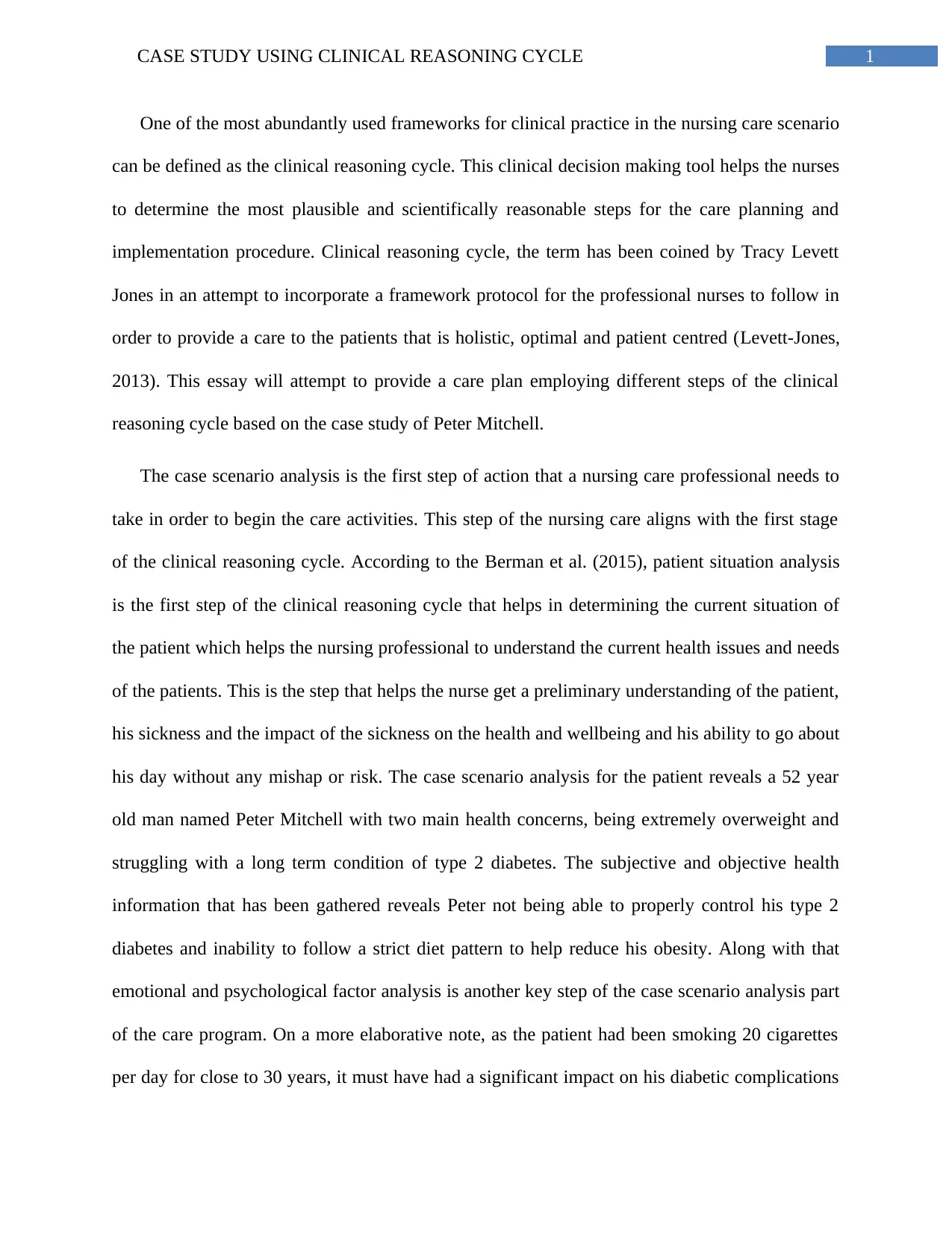
1CASE STUDY USING CLINICAL REASONING CYCLE
One of the most abundantly used frameworks for clinical practice in the nursing care scenario
can be defined as the clinical reasoning cycle. This clinical decision making tool helps the nurses
to determine the most plausible and scientifically reasonable steps for the care planning and
implementation procedure. Clinical reasoning cycle, the term has been coined by Tracy Levett
Jones in an attempt to incorporate a framework protocol for the professional nurses to follow in
order to provide a care to the patients that is holistic, optimal and patient centred (Levett-Jones,
2013). This essay will attempt to provide a care plan employing different steps of the clinical
reasoning cycle based on the case study of Peter Mitchell.
The case scenario analysis is the first step of action that a nursing care professional needs to
take in order to begin the care activities. This step of the nursing care aligns with the first stage
of the clinical reasoning cycle. According to the Berman et al. (2015), patient situation analysis
is the first step of the clinical reasoning cycle that helps in determining the current situation of
the patient which helps the nursing professional to understand the current health issues and needs
of the patients. This is the step that helps the nurse get a preliminary understanding of the patient,
his sickness and the impact of the sickness on the health and wellbeing and his ability to go about
his day without any mishap or risk. The case scenario analysis for the patient reveals a 52 year
old man named Peter Mitchell with two main health concerns, being extremely overweight and
struggling with a long term condition of type 2 diabetes. The subjective and objective health
information that has been gathered reveals Peter not being able to properly control his type 2
diabetes and inability to follow a strict diet pattern to help reduce his obesity. Along with that
emotional and psychological factor analysis is another key step of the case scenario analysis part
of the care program. On a more elaborative note, as the patient had been smoking 20 cigarettes
per day for close to 30 years, it must have had a significant impact on his diabetic complications
One of the most abundantly used frameworks for clinical practice in the nursing care scenario
can be defined as the clinical reasoning cycle. This clinical decision making tool helps the nurses
to determine the most plausible and scientifically reasonable steps for the care planning and
implementation procedure. Clinical reasoning cycle, the term has been coined by Tracy Levett
Jones in an attempt to incorporate a framework protocol for the professional nurses to follow in
order to provide a care to the patients that is holistic, optimal and patient centred (Levett-Jones,
2013). This essay will attempt to provide a care plan employing different steps of the clinical
reasoning cycle based on the case study of Peter Mitchell.
The case scenario analysis is the first step of action that a nursing care professional needs to
take in order to begin the care activities. This step of the nursing care aligns with the first stage
of the clinical reasoning cycle. According to the Berman et al. (2015), patient situation analysis
is the first step of the clinical reasoning cycle that helps in determining the current situation of
the patient which helps the nursing professional to understand the current health issues and needs
of the patients. This is the step that helps the nurse get a preliminary understanding of the patient,
his sickness and the impact of the sickness on the health and wellbeing and his ability to go about
his day without any mishap or risk. The case scenario analysis for the patient reveals a 52 year
old man named Peter Mitchell with two main health concerns, being extremely overweight and
struggling with a long term condition of type 2 diabetes. The subjective and objective health
information that has been gathered reveals Peter not being able to properly control his type 2
diabetes and inability to follow a strict diet pattern to help reduce his obesity. Along with that
emotional and psychological factor analysis is another key step of the case scenario analysis part
of the care program. On a more elaborative note, as the patient had been smoking 20 cigarettes
per day for close to 30 years, it must have had a significant impact on his diabetic complications
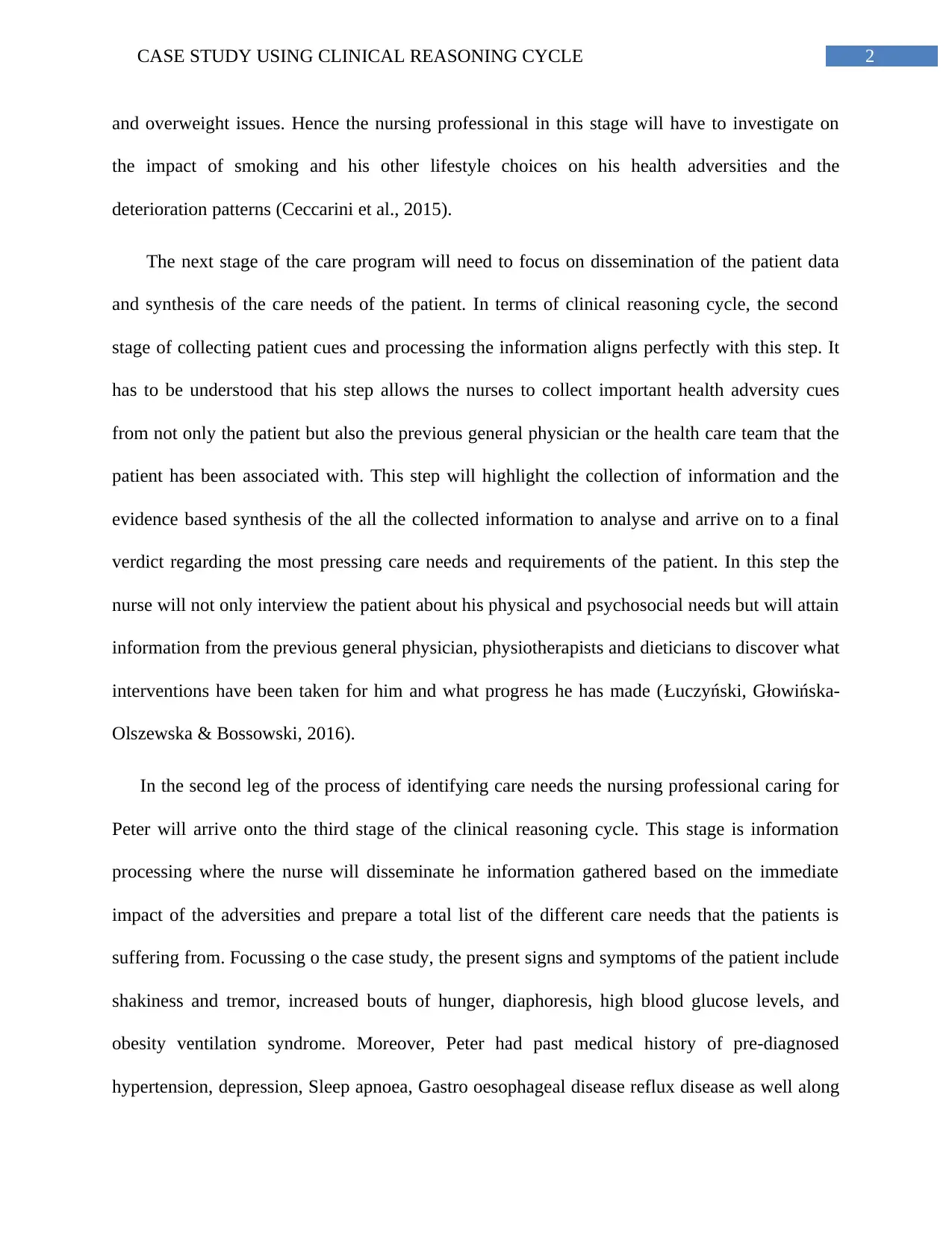
2CASE STUDY USING CLINICAL REASONING CYCLE
and overweight issues. Hence the nursing professional in this stage will have to investigate on
the impact of smoking and his other lifestyle choices on his health adversities and the
deterioration patterns (Ceccarini et al., 2015).
The next stage of the care program will need to focus on dissemination of the patient data
and synthesis of the care needs of the patient. In terms of clinical reasoning cycle, the second
stage of collecting patient cues and processing the information aligns perfectly with this step. It
has to be understood that his step allows the nurses to collect important health adversity cues
from not only the patient but also the previous general physician or the health care team that the
patient has been associated with. This step will highlight the collection of information and the
evidence based synthesis of the all the collected information to analyse and arrive on to a final
verdict regarding the most pressing care needs and requirements of the patient. In this step the
nurse will not only interview the patient about his physical and psychosocial needs but will attain
information from the previous general physician, physiotherapists and dieticians to discover what
interventions have been taken for him and what progress he has made (Łuczyński, Głowińska-
Olszewska & Bossowski, 2016).
In the second leg of the process of identifying care needs the nursing professional caring for
Peter will arrive onto the third stage of the clinical reasoning cycle. This stage is information
processing where the nurse will disseminate he information gathered based on the immediate
impact of the adversities and prepare a total list of the different care needs that the patients is
suffering from. Focussing o the case study, the present signs and symptoms of the patient include
shakiness and tremor, increased bouts of hunger, diaphoresis, high blood glucose levels, and
obesity ventilation syndrome. Moreover, Peter had past medical history of pre-diagnosed
hypertension, depression, Sleep apnoea, Gastro oesophageal disease reflux disease as well along
and overweight issues. Hence the nursing professional in this stage will have to investigate on
the impact of smoking and his other lifestyle choices on his health adversities and the
deterioration patterns (Ceccarini et al., 2015).
The next stage of the care program will need to focus on dissemination of the patient data
and synthesis of the care needs of the patient. In terms of clinical reasoning cycle, the second
stage of collecting patient cues and processing the information aligns perfectly with this step. It
has to be understood that his step allows the nurses to collect important health adversity cues
from not only the patient but also the previous general physician or the health care team that the
patient has been associated with. This step will highlight the collection of information and the
evidence based synthesis of the all the collected information to analyse and arrive on to a final
verdict regarding the most pressing care needs and requirements of the patient. In this step the
nurse will not only interview the patient about his physical and psychosocial needs but will attain
information from the previous general physician, physiotherapists and dieticians to discover what
interventions have been taken for him and what progress he has made (Łuczyński, Głowińska-
Olszewska & Bossowski, 2016).
In the second leg of the process of identifying care needs the nursing professional caring for
Peter will arrive onto the third stage of the clinical reasoning cycle. This stage is information
processing where the nurse will disseminate he information gathered based on the immediate
impact of the adversities and prepare a total list of the different care needs that the patients is
suffering from. Focussing o the case study, the present signs and symptoms of the patient include
shakiness and tremor, increased bouts of hunger, diaphoresis, high blood glucose levels, and
obesity ventilation syndrome. Moreover, Peter had past medical history of pre-diagnosed
hypertension, depression, Sleep apnoea, Gastro oesophageal disease reflux disease as well along
⊘ This is a preview!⊘
Do you want full access?
Subscribe today to unlock all pages.

Trusted by 1+ million students worldwide
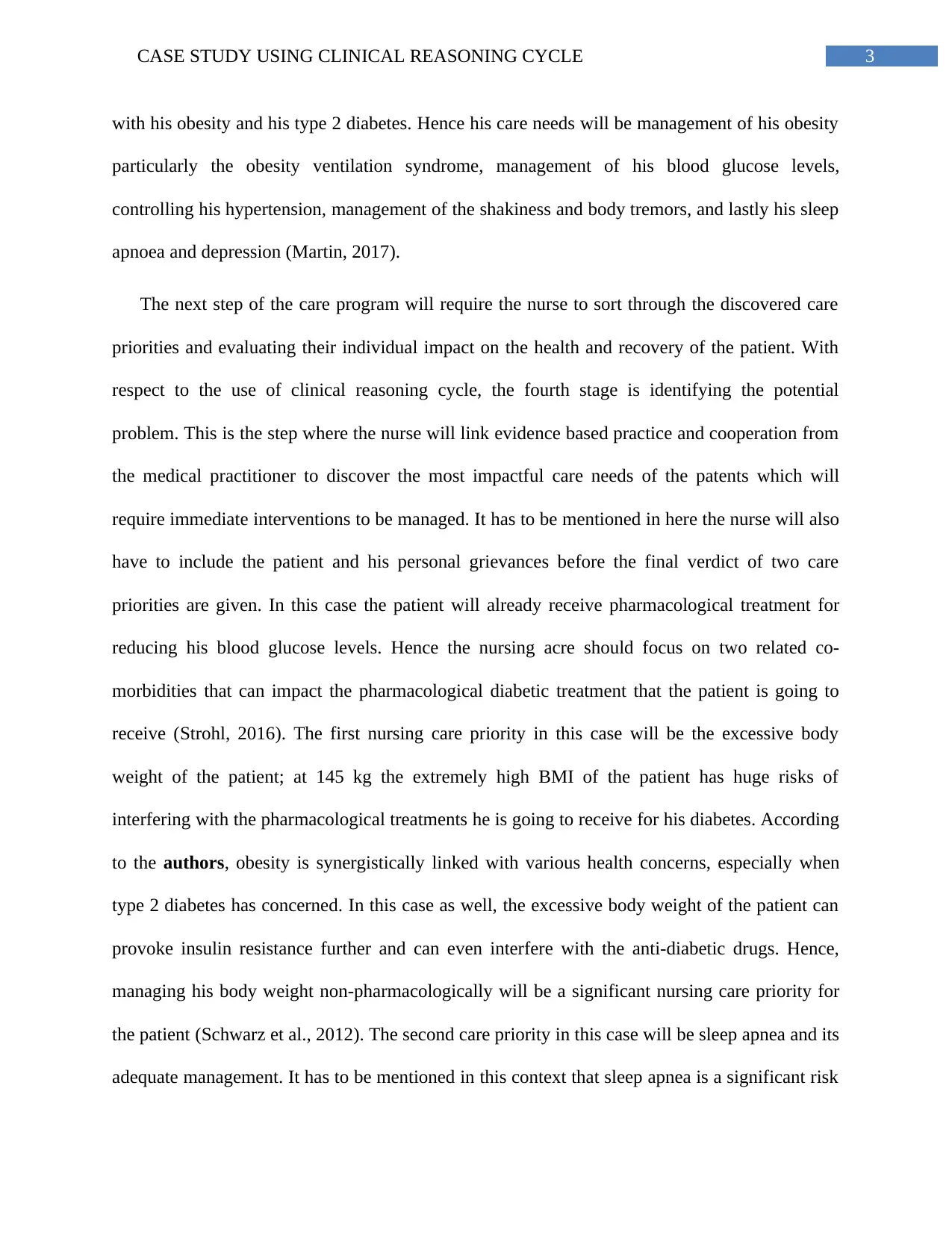
3CASE STUDY USING CLINICAL REASONING CYCLE
with his obesity and his type 2 diabetes. Hence his care needs will be management of his obesity
particularly the obesity ventilation syndrome, management of his blood glucose levels,
controlling his hypertension, management of the shakiness and body tremors, and lastly his sleep
apnoea and depression (Martin, 2017).
The next step of the care program will require the nurse to sort through the discovered care
priorities and evaluating their individual impact on the health and recovery of the patient. With
respect to the use of clinical reasoning cycle, the fourth stage is identifying the potential
problem. This is the step where the nurse will link evidence based practice and cooperation from
the medical practitioner to discover the most impactful care needs of the patents which will
require immediate interventions to be managed. It has to be mentioned in here the nurse will also
have to include the patient and his personal grievances before the final verdict of two care
priorities are given. In this case the patient will already receive pharmacological treatment for
reducing his blood glucose levels. Hence the nursing acre should focus on two related co-
morbidities that can impact the pharmacological diabetic treatment that the patient is going to
receive (Strohl, 2016). The first nursing care priority in this case will be the excessive body
weight of the patient; at 145 kg the extremely high BMI of the patient has huge risks of
interfering with the pharmacological treatments he is going to receive for his diabetes. According
to the authors, obesity is synergistically linked with various health concerns, especially when
type 2 diabetes has concerned. In this case as well, the excessive body weight of the patient can
provoke insulin resistance further and can even interfere with the anti-diabetic drugs. Hence,
managing his body weight non-pharmacologically will be a significant nursing care priority for
the patient (Schwarz et al., 2012). The second care priority in this case will be sleep apnea and its
adequate management. It has to be mentioned in this context that sleep apnea is a significant risk
with his obesity and his type 2 diabetes. Hence his care needs will be management of his obesity
particularly the obesity ventilation syndrome, management of his blood glucose levels,
controlling his hypertension, management of the shakiness and body tremors, and lastly his sleep
apnoea and depression (Martin, 2017).
The next step of the care program will require the nurse to sort through the discovered care
priorities and evaluating their individual impact on the health and recovery of the patient. With
respect to the use of clinical reasoning cycle, the fourth stage is identifying the potential
problem. This is the step where the nurse will link evidence based practice and cooperation from
the medical practitioner to discover the most impactful care needs of the patents which will
require immediate interventions to be managed. It has to be mentioned in here the nurse will also
have to include the patient and his personal grievances before the final verdict of two care
priorities are given. In this case the patient will already receive pharmacological treatment for
reducing his blood glucose levels. Hence the nursing acre should focus on two related co-
morbidities that can impact the pharmacological diabetic treatment that the patient is going to
receive (Strohl, 2016). The first nursing care priority in this case will be the excessive body
weight of the patient; at 145 kg the extremely high BMI of the patient has huge risks of
interfering with the pharmacological treatments he is going to receive for his diabetes. According
to the authors, obesity is synergistically linked with various health concerns, especially when
type 2 diabetes has concerned. In this case as well, the excessive body weight of the patient can
provoke insulin resistance further and can even interfere with the anti-diabetic drugs. Hence,
managing his body weight non-pharmacologically will be a significant nursing care priority for
the patient (Schwarz et al., 2012). The second care priority in this case will be sleep apnea and its
adequate management. It has to be mentioned in this context that sleep apnea is a significant risk
Paraphrase This Document
Need a fresh take? Get an instant paraphrase of this document with our AI Paraphraser
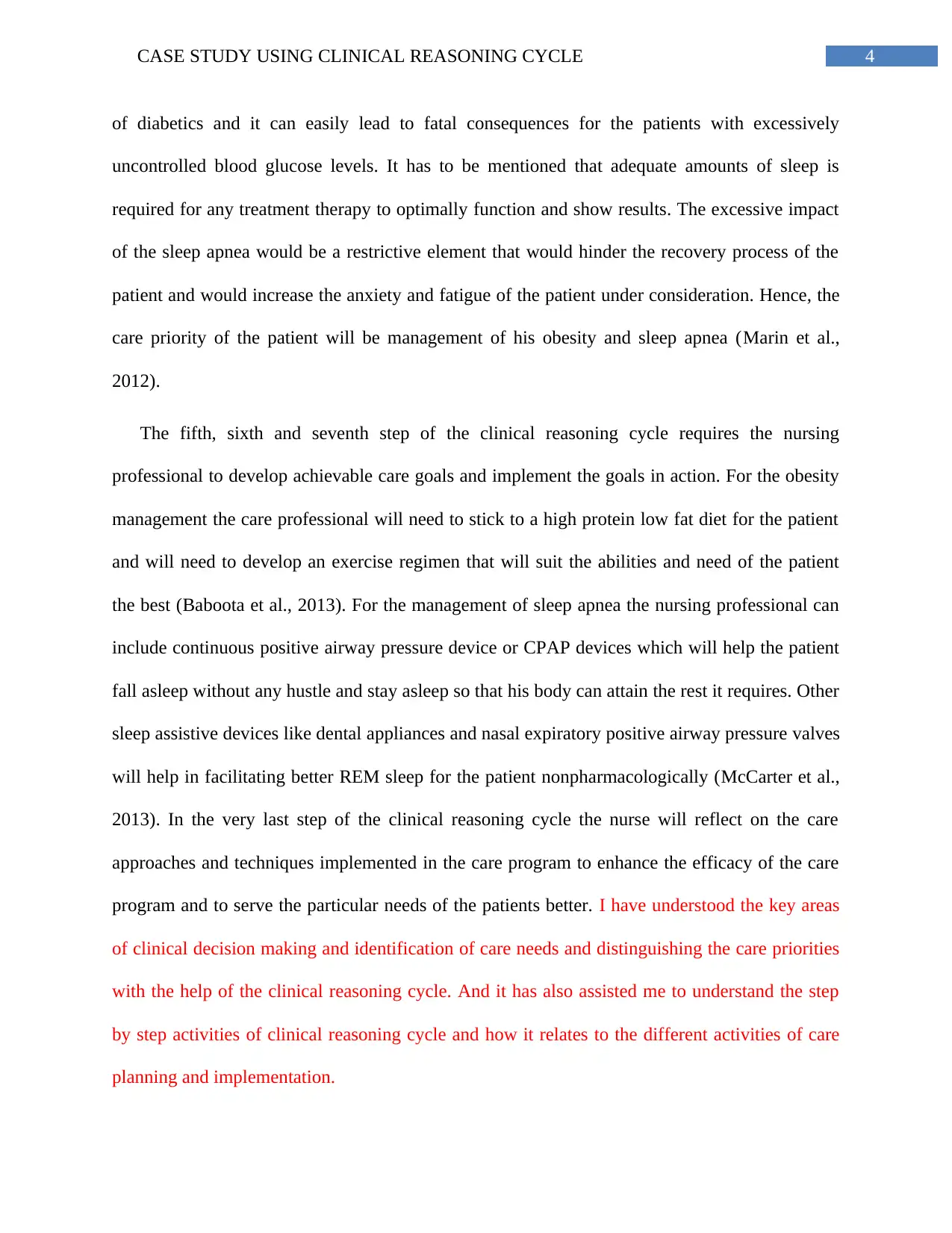
4CASE STUDY USING CLINICAL REASONING CYCLE
of diabetics and it can easily lead to fatal consequences for the patients with excessively
uncontrolled blood glucose levels. It has to be mentioned that adequate amounts of sleep is
required for any treatment therapy to optimally function and show results. The excessive impact
of the sleep apnea would be a restrictive element that would hinder the recovery process of the
patient and would increase the anxiety and fatigue of the patient under consideration. Hence, the
care priority of the patient will be management of his obesity and sleep apnea (Marin et al.,
2012).
The fifth, sixth and seventh step of the clinical reasoning cycle requires the nursing
professional to develop achievable care goals and implement the goals in action. For the obesity
management the care professional will need to stick to a high protein low fat diet for the patient
and will need to develop an exercise regimen that will suit the abilities and need of the patient
the best (Baboota et al., 2013). For the management of sleep apnea the nursing professional can
include continuous positive airway pressure device or CPAP devices which will help the patient
fall asleep without any hustle and stay asleep so that his body can attain the rest it requires. Other
sleep assistive devices like dental appliances and nasal expiratory positive airway pressure valves
will help in facilitating better REM sleep for the patient nonpharmacologically (McCarter et al.,
2013). In the very last step of the clinical reasoning cycle the nurse will reflect on the care
approaches and techniques implemented in the care program to enhance the efficacy of the care
program and to serve the particular needs of the patients better. I have understood the key areas
of clinical decision making and identification of care needs and distinguishing the care priorities
with the help of the clinical reasoning cycle. And it has also assisted me to understand the step
by step activities of clinical reasoning cycle and how it relates to the different activities of care
planning and implementation.
of diabetics and it can easily lead to fatal consequences for the patients with excessively
uncontrolled blood glucose levels. It has to be mentioned that adequate amounts of sleep is
required for any treatment therapy to optimally function and show results. The excessive impact
of the sleep apnea would be a restrictive element that would hinder the recovery process of the
patient and would increase the anxiety and fatigue of the patient under consideration. Hence, the
care priority of the patient will be management of his obesity and sleep apnea (Marin et al.,
2012).
The fifth, sixth and seventh step of the clinical reasoning cycle requires the nursing
professional to develop achievable care goals and implement the goals in action. For the obesity
management the care professional will need to stick to a high protein low fat diet for the patient
and will need to develop an exercise regimen that will suit the abilities and need of the patient
the best (Baboota et al., 2013). For the management of sleep apnea the nursing professional can
include continuous positive airway pressure device or CPAP devices which will help the patient
fall asleep without any hustle and stay asleep so that his body can attain the rest it requires. Other
sleep assistive devices like dental appliances and nasal expiratory positive airway pressure valves
will help in facilitating better REM sleep for the patient nonpharmacologically (McCarter et al.,
2013). In the very last step of the clinical reasoning cycle the nurse will reflect on the care
approaches and techniques implemented in the care program to enhance the efficacy of the care
program and to serve the particular needs of the patients better. I have understood the key areas
of clinical decision making and identification of care needs and distinguishing the care priorities
with the help of the clinical reasoning cycle. And it has also assisted me to understand the step
by step activities of clinical reasoning cycle and how it relates to the different activities of care
planning and implementation.
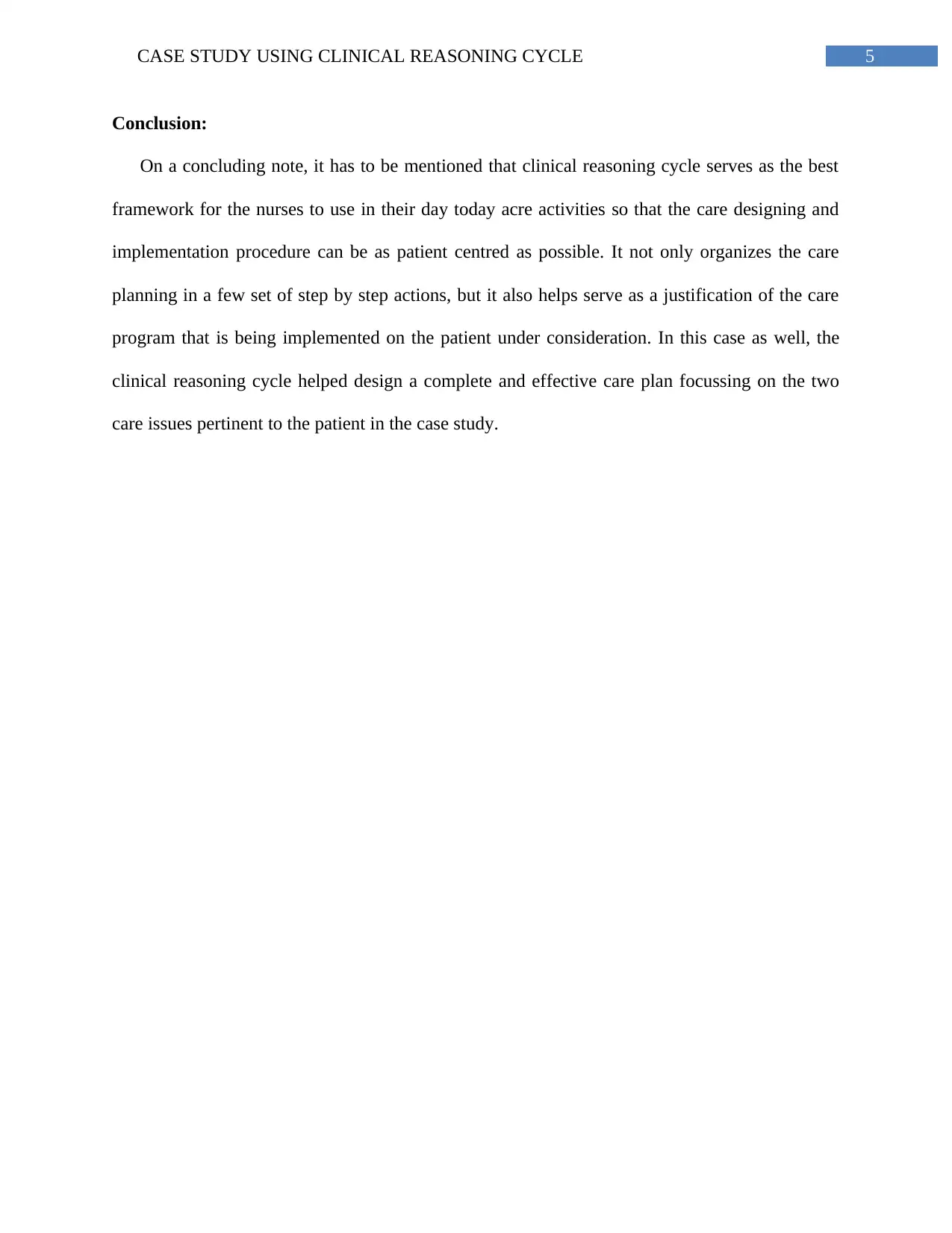
5CASE STUDY USING CLINICAL REASONING CYCLE
Conclusion:
On a concluding note, it has to be mentioned that clinical reasoning cycle serves as the best
framework for the nurses to use in their day today acre activities so that the care designing and
implementation procedure can be as patient centred as possible. It not only organizes the care
planning in a few set of step by step actions, but it also helps serve as a justification of the care
program that is being implemented on the patient under consideration. In this case as well, the
clinical reasoning cycle helped design a complete and effective care plan focussing on the two
care issues pertinent to the patient in the case study.
Conclusion:
On a concluding note, it has to be mentioned that clinical reasoning cycle serves as the best
framework for the nurses to use in their day today acre activities so that the care designing and
implementation procedure can be as patient centred as possible. It not only organizes the care
planning in a few set of step by step actions, but it also helps serve as a justification of the care
program that is being implemented on the patient under consideration. In this case as well, the
clinical reasoning cycle helped design a complete and effective care plan focussing on the two
care issues pertinent to the patient in the case study.
⊘ This is a preview!⊘
Do you want full access?
Subscribe today to unlock all pages.

Trusted by 1+ million students worldwide
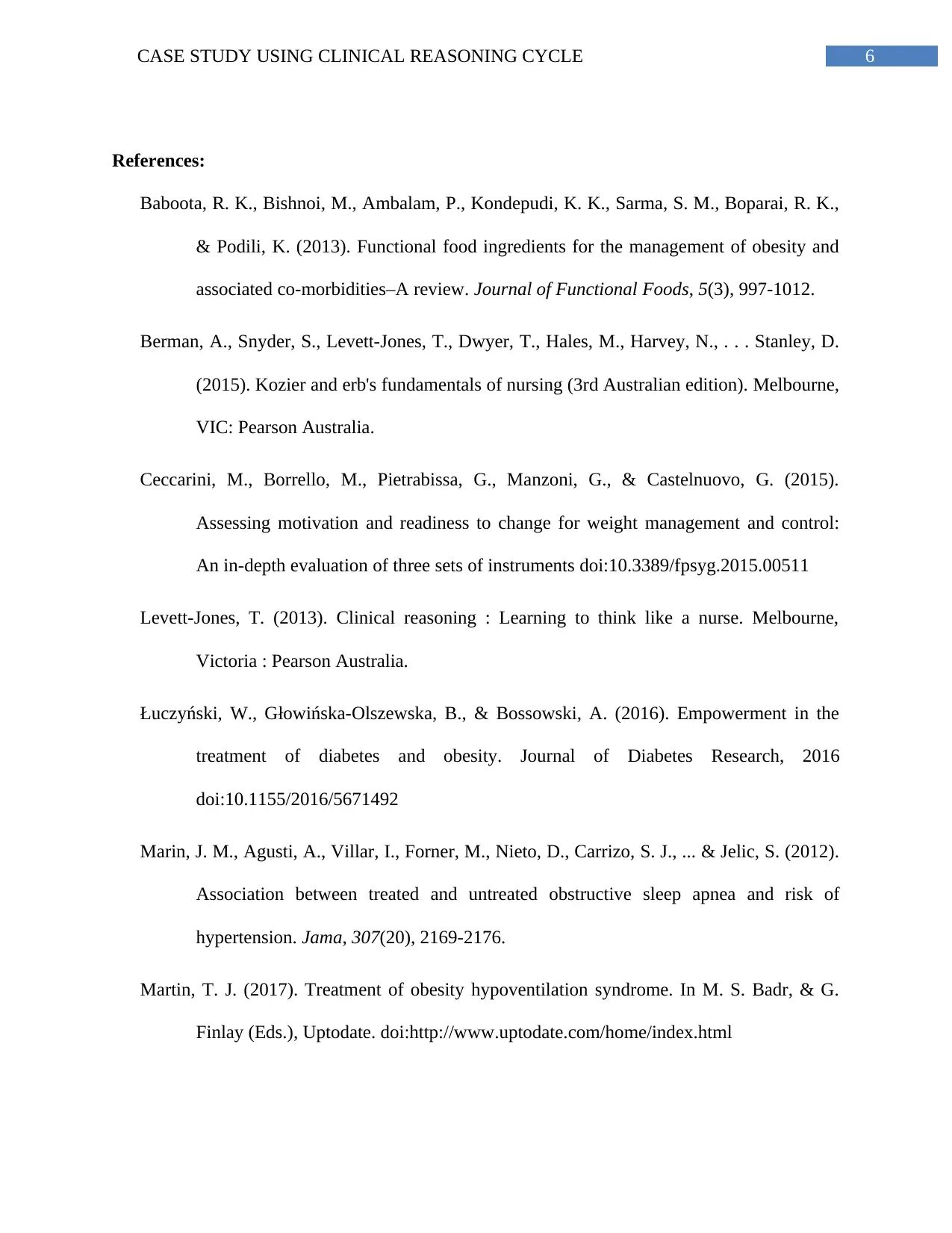
6CASE STUDY USING CLINICAL REASONING CYCLE
References:
Baboota, R. K., Bishnoi, M., Ambalam, P., Kondepudi, K. K., Sarma, S. M., Boparai, R. K.,
& Podili, K. (2013). Functional food ingredients for the management of obesity and
associated co-morbidities–A review. Journal of Functional Foods, 5(3), 997-1012.
Berman, A., Snyder, S., Levett-Jones, T., Dwyer, T., Hales, M., Harvey, N., . . . Stanley, D.
(2015). Kozier and erb's fundamentals of nursing (3rd Australian edition). Melbourne,
VIC: Pearson Australia.
Ceccarini, M., Borrello, M., Pietrabissa, G., Manzoni, G., & Castelnuovo, G. (2015).
Assessing motivation and readiness to change for weight management and control:
An in-depth evaluation of three sets of instruments doi:10.3389/fpsyg.2015.00511
Levett-Jones, T. (2013). Clinical reasoning : Learning to think like a nurse. Melbourne,
Victoria : Pearson Australia.
Łuczyński, W., Głowińska-Olszewska, B., & Bossowski, A. (2016). Empowerment in the
treatment of diabetes and obesity. Journal of Diabetes Research, 2016
doi:10.1155/2016/5671492
Marin, J. M., Agusti, A., Villar, I., Forner, M., Nieto, D., Carrizo, S. J., ... & Jelic, S. (2012).
Association between treated and untreated obstructive sleep apnea and risk of
hypertension. Jama, 307(20), 2169-2176.
Martin, T. J. (2017). Treatment of obesity hypoventilation syndrome. In M. S. Badr, & G.
Finlay (Eds.), Uptodate. doi:http://www.uptodate.com/home/index.html
References:
Baboota, R. K., Bishnoi, M., Ambalam, P., Kondepudi, K. K., Sarma, S. M., Boparai, R. K.,
& Podili, K. (2013). Functional food ingredients for the management of obesity and
associated co-morbidities–A review. Journal of Functional Foods, 5(3), 997-1012.
Berman, A., Snyder, S., Levett-Jones, T., Dwyer, T., Hales, M., Harvey, N., . . . Stanley, D.
(2015). Kozier and erb's fundamentals of nursing (3rd Australian edition). Melbourne,
VIC: Pearson Australia.
Ceccarini, M., Borrello, M., Pietrabissa, G., Manzoni, G., & Castelnuovo, G. (2015).
Assessing motivation and readiness to change for weight management and control:
An in-depth evaluation of three sets of instruments doi:10.3389/fpsyg.2015.00511
Levett-Jones, T. (2013). Clinical reasoning : Learning to think like a nurse. Melbourne,
Victoria : Pearson Australia.
Łuczyński, W., Głowińska-Olszewska, B., & Bossowski, A. (2016). Empowerment in the
treatment of diabetes and obesity. Journal of Diabetes Research, 2016
doi:10.1155/2016/5671492
Marin, J. M., Agusti, A., Villar, I., Forner, M., Nieto, D., Carrizo, S. J., ... & Jelic, S. (2012).
Association between treated and untreated obstructive sleep apnea and risk of
hypertension. Jama, 307(20), 2169-2176.
Martin, T. J. (2017). Treatment of obesity hypoventilation syndrome. In M. S. Badr, & G.
Finlay (Eds.), Uptodate. doi:http://www.uptodate.com/home/index.html
Paraphrase This Document
Need a fresh take? Get an instant paraphrase of this document with our AI Paraphraser
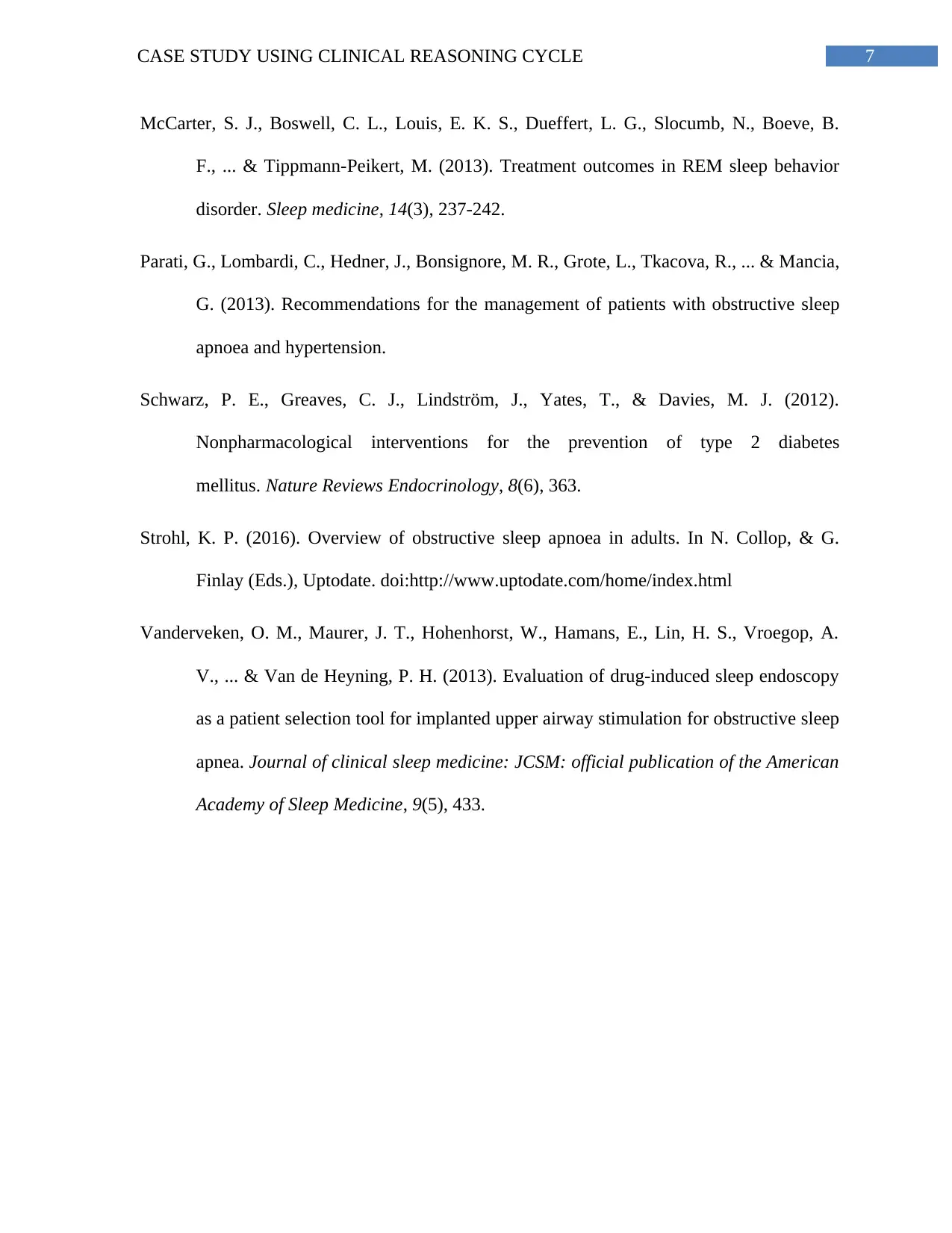
7CASE STUDY USING CLINICAL REASONING CYCLE
McCarter, S. J., Boswell, C. L., Louis, E. K. S., Dueffert, L. G., Slocumb, N., Boeve, B.
F., ... & Tippmann-Peikert, M. (2013). Treatment outcomes in REM sleep behavior
disorder. Sleep medicine, 14(3), 237-242.
Parati, G., Lombardi, C., Hedner, J., Bonsignore, M. R., Grote, L., Tkacova, R., ... & Mancia,
G. (2013). Recommendations for the management of patients with obstructive sleep
apnoea and hypertension.
Schwarz, P. E., Greaves, C. J., Lindström, J., Yates, T., & Davies, M. J. (2012).
Nonpharmacological interventions for the prevention of type 2 diabetes
mellitus. Nature Reviews Endocrinology, 8(6), 363.
Strohl, K. P. (2016). Overview of obstructive sleep apnoea in adults. In N. Collop, & G.
Finlay (Eds.), Uptodate. doi:http://www.uptodate.com/home/index.html
Vanderveken, O. M., Maurer, J. T., Hohenhorst, W., Hamans, E., Lin, H. S., Vroegop, A.
V., ... & Van de Heyning, P. H. (2013). Evaluation of drug-induced sleep endoscopy
as a patient selection tool for implanted upper airway stimulation for obstructive sleep
apnea. Journal of clinical sleep medicine: JCSM: official publication of the American
Academy of Sleep Medicine, 9(5), 433.
McCarter, S. J., Boswell, C. L., Louis, E. K. S., Dueffert, L. G., Slocumb, N., Boeve, B.
F., ... & Tippmann-Peikert, M. (2013). Treatment outcomes in REM sleep behavior
disorder. Sleep medicine, 14(3), 237-242.
Parati, G., Lombardi, C., Hedner, J., Bonsignore, M. R., Grote, L., Tkacova, R., ... & Mancia,
G. (2013). Recommendations for the management of patients with obstructive sleep
apnoea and hypertension.
Schwarz, P. E., Greaves, C. J., Lindström, J., Yates, T., & Davies, M. J. (2012).
Nonpharmacological interventions for the prevention of type 2 diabetes
mellitus. Nature Reviews Endocrinology, 8(6), 363.
Strohl, K. P. (2016). Overview of obstructive sleep apnoea in adults. In N. Collop, & G.
Finlay (Eds.), Uptodate. doi:http://www.uptodate.com/home/index.html
Vanderveken, O. M., Maurer, J. T., Hohenhorst, W., Hamans, E., Lin, H. S., Vroegop, A.
V., ... & Van de Heyning, P. H. (2013). Evaluation of drug-induced sleep endoscopy
as a patient selection tool for implanted upper airway stimulation for obstructive sleep
apnea. Journal of clinical sleep medicine: JCSM: official publication of the American
Academy of Sleep Medicine, 9(5), 433.
1 out of 8
Related Documents
Your All-in-One AI-Powered Toolkit for Academic Success.
+13062052269
info@desklib.com
Available 24*7 on WhatsApp / Email
![[object Object]](/_next/static/media/star-bottom.7253800d.svg)
Unlock your academic potential
Copyright © 2020–2025 A2Z Services. All Rights Reserved. Developed and managed by ZUCOL.





